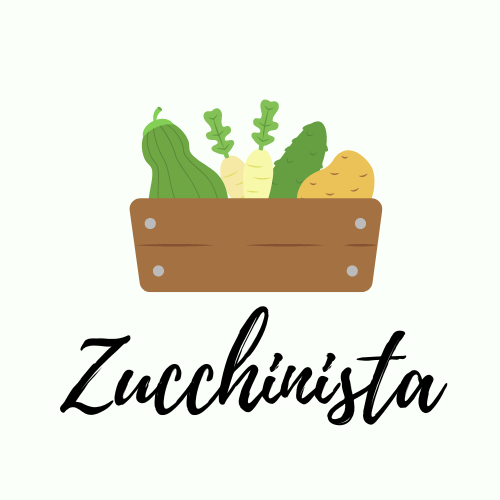This soup is so deliciously spicy and fruity and brings the best aspects out of good old swedes or rutabagas – an often overlooked and underestimated vegetable.
It brings just about the right balance of delicate spiciness, sweet and sour fruity notes and creamy coconut milk. The nutrient-rich root vegetables are combined with the curry ingredients that are packed with essential oils and phytochemicals.
The original idea behind this recipe was that I wanted to make a carrot soup that was cooked in the manner of a typical pumpkin soup. At least the kind of pumpkin soup that is preferred these days – finely pureed, flavored with curry and ginger with an Asian influence and refined with coconut milk. The aim was to use the pure, fresh and sweet taste of the carrots for the soup – without the slightly musty notes that are often characteristic of the pumpkin.
But then it occurred to me that I spontaneously had to cook more for some people and thus had to practically double the amount of the recipe. Actually, there had to be more carrots – but I don’t have them in my stash anymore. But a large turnip, and so this had to be used for the soup and the curried carrot soup became a curried carrot and swede soup. Instead of a curry powder based on Indian spices, I wanted to use a zesty, more lemongrass and galangal based Thai curry paste.
Far too often, swedes are still underestimated in culinary terms and considered a food substitute from times of war and hardship. Perhaps the traditional methods of preparation also play a role in this assessment, in which rutabagas were mostly served relatively unseasoned as a chowder in clear stews or at most braised with fatty meats such as pork belly. And I have to say, when rutabagas are simply cooked, they often develop a bitter note and have a rather watery texture that is not as creamy as starchier vegetables like something like potatoes. Therefore, it is more advisable to either prepare rutabagas with a drier cooking method – such as roasting or braising in the oven – and to choose a higher-fat preparation. This is the best way to bring out their deliciously sweet, slightly tart flavour.
If the swede has a distinctly bitter taste – this can also depend on the variety, but also simply on the weather and soil conditions – it often helps to blanch the diced swedes before cooking and then discard the cooking water. But strong seasoning also helps to tone down the bitter notes. In this recipe, they are contrasted with the sweet and fruity notes of the carrots and orange juice and the spiciness of the Thai curry paste.
And so this soup became a successful fusion of European vegetables and Asian spices and preparation methods. A modern world cuisine, so to speak. One should simply dare to tear ingredients out of their historical-geographical context and combine them in unconventional ways – the result is often surprisingly good!
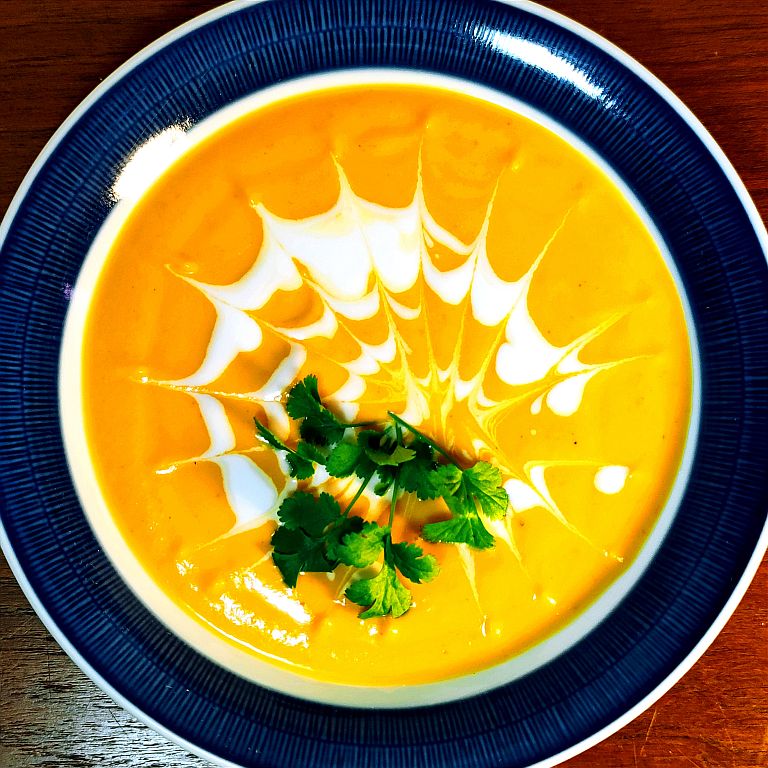
Why You’ll Love This Recipe
- It’s super creamy – the soup gets its nice creamy, rich texture from the boiled down / reduced coconut milk. But the soup also gets creamier the more finely it is pureed.
- It’s brightly coloured – the bright orange colour of this soup acts like a ray of sunshine on the mind and brightens the mood.
- It’s fruity and tangy – the orange juice acts as a freshness kick that further peps up the soup and creates the right balance to the spicy and earthy notes
- It’s spicy and savoury – the mild Panang Thai Curry Paste brings a balanced, not too spicy chilli heat and unmistakable Thai flavours from lemongrass, kaffir lime paste and galangal.
- It’s light and wholesome – the Carrot and Swede Soup adapts to pretty much any dietary prescription or dietary pattern. It is vegan, paleo and allergen-free.
- It is nourishing and healthy – thanks to its root vegetable base, it is packed with micronutrients, antioxidants and anti-inflammatory ingredients.
- It is uncomplicated and quick – the soup can be prepared in large quantities without much effort and is therefore also great for making in advance
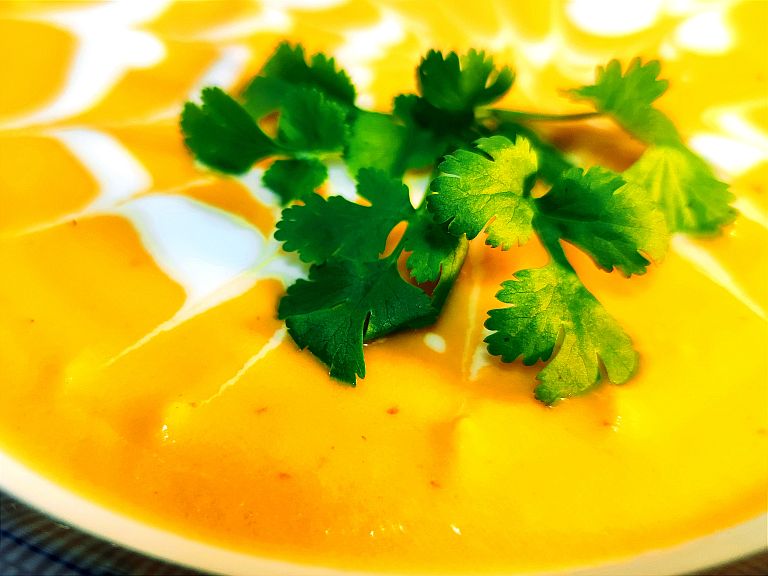
Benefits of this recipe
The health benefits of swedes / rutabaga: swedes are an excellent source of micronutrients.
Their vitamin C content in particular is exceptionally high, but vitamin K and vitamin B6 are also present in appreciable quantities. They also contain minerals and trace elements such as calcium, potassium, magnesium, phosphorus, copper and manganese. As a relative of the cabbage family, they contain the glycosinolates peculiar to cruciferous vegetables, which have anti-infectious and anti-inflammatory effects. Other antioxidants such as lutein and carotenes are also present in significant quantities.
For the low carb diet, rutabaga is an excellent choice because it contains only 3.7 g of carbohydrates per 100 g and instead has a relatively high amount of fibre. By comparison, potatoes have 15 % carbohydrates.
Carrots, on the other hand, are even more nutritious in relation to the basic quantity. They are particularly rich in carotenes, which are the precursor of vitamin A, vitamin K and many B vitamins, especially biotin. They are particularly rich in the minerals iron, zinc, copper, manganese and iodine. Besides carotenes, they contain many other secondary plant substances such as lutein and lycopene.
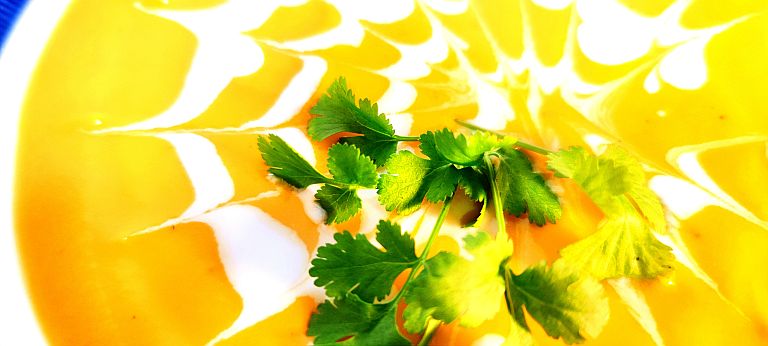
Ingredients – what you’ll need to make the Curried Carrot and Swede Soup
- Swede – also known as rutabaga or Swedish turnip. Since rutabagas were bred in Scandinavia in the 17th century, from the white turnips, they also became known as Swedish turnips. For this recipe, I used a yellow-fleshed variety of swedes.
- Carrots – the reliable classic winter vegetable. Here I have used larger storage carrots, as they are available throughout the winter. But you can also use fresher, more tender carrots.
- Garlic – the garlic adds even more hearty spice and rounds off the soup in a tasty way. Since the Panang Thai Curry Paste already contains garlic, you don’t need to go the extra step of adding fresh garlic.
- Vegetable broth – using vegetable broth makes the broth vegan and vegetarian. If you’re an omnivore and have other meat-based broths on hand like chicken broth or bone broth, feel free to use those as well.
- Coconut milk – I used full-fat canned coconut milk, made only from coconut meat and water.
- Panang Curry Paste – Panang Curry Paste is the mildest of the classic Thai curry pastes. The main ingredients are garlic, shallots, chillies, lemongrass, galangal, makrut lime zest, white pepper and cilantro roots. Traditionally, it is used to prepare curries with chopped peanuts. Often chicken or vegetarian vegetable curries are prepared with this curry paste. This classic connection with peanuts is of course missing here. I used the panang paste for this soup so as not to foreground the chilli heat and instead let the spicier ethereal notes of the other spices take effect.
- Orange juice – The acidity and sweetness from the juice round off the soup perfectly and add a tangy twist. I used direct juice from the bottle here
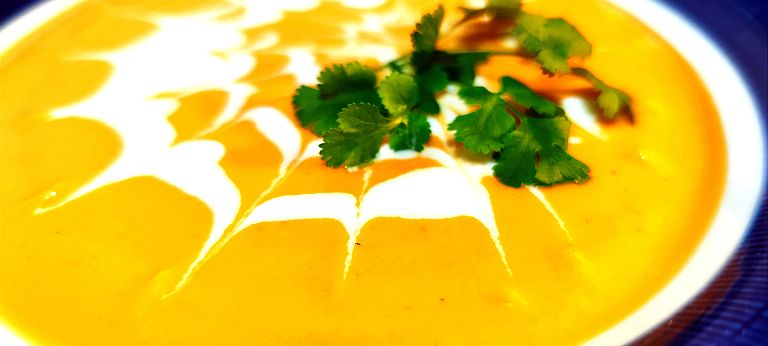
Substitutes and variations
- Swede – instead of swedes, you can also use white autumn turnips or the more tender spring turnips. However, the soup might not be quite as bright yellow-orange.
- Carrots – I wouldn’t replace the entire amount of carrots, but you can experiment with the weighting of the root vegetables. How about substituting some of the carrots with parsnips or adding some parsley roots for a spicier base flavour?
- Garlic – Since the Panang Thai Curry Paste already contains garlic, you can skip the extra step of adding fresh garlic. Or, if you like the soup particularly hearty, you can also add onions. In this case, you can first sauté the diced onions in oil, then add the diced root vegetables, sauté for a while and then add the stock and continue the recipe as described from step 5.
- Orange juice – instead of orange juice, you can also use the juice of freshly squeezed oranges or add the flesh of an orange that has been pitted and the peel removed before pureeing. Or, for a different fruity twist, try apple juice or a tropical fruit juice such as guava juice or passion fruit juice.
- Panang Thai curry paste – the most similar to Panang paste is the slightly spicier Red Thai curry paste. The Massaman Curry Paste has slightly different, slightly Indian flavours of cumin and cinnamon. Instead of Thai curry paste, you can also season the Carrot and Swede Soup with curry powder, chilli flakes and ginger or combine the spices for the curry individually.

Best ways to enjoy the Curried Carrot and Swede Soup
Serve this creamy carrot and swede soup with an extra sprinkle of coconut milk.
For a spicy and aromatic finish, serve the soup with a topping of:
- tender and young coriander leaves freshly plucked from the stems
- chopped fresh chilli peppers
- fresh Thai basil
- Makrut lime leaves cut into strips
- chopped peanuts or roasted cashew nuts or coconut flakes
This soup has a super rich, creamy and delicate texture. To add some variety to the texture, you can finely dice or strip a small portion of the carrots and turnips, cook them in a separate pot until al dente and garnish the finished cream soup with them.
To make it a complete, filling meal, serve with a side of jasmine rice or sticky rice or with a fresh green salad.
Spice it up with a protein of your choice – an ideal vegan choice is roasted tempeh or tofu. Non-vegetarian options include strips of grilled chicken or fried prawns.
How to store the Curried Carrot and Swede Soup
This soup is easy to prepare in advance and is even more aromatic and harmonious when stored for a day and reheated. It keeps easily for up to 4 days in an airtight container in the fridge, making it ideal for a weekend meal prep.
As it is relatively effortless to prepare in large quantities, it is ideal for large gatherings, for guests and as a takeaway for parties and celebrations.
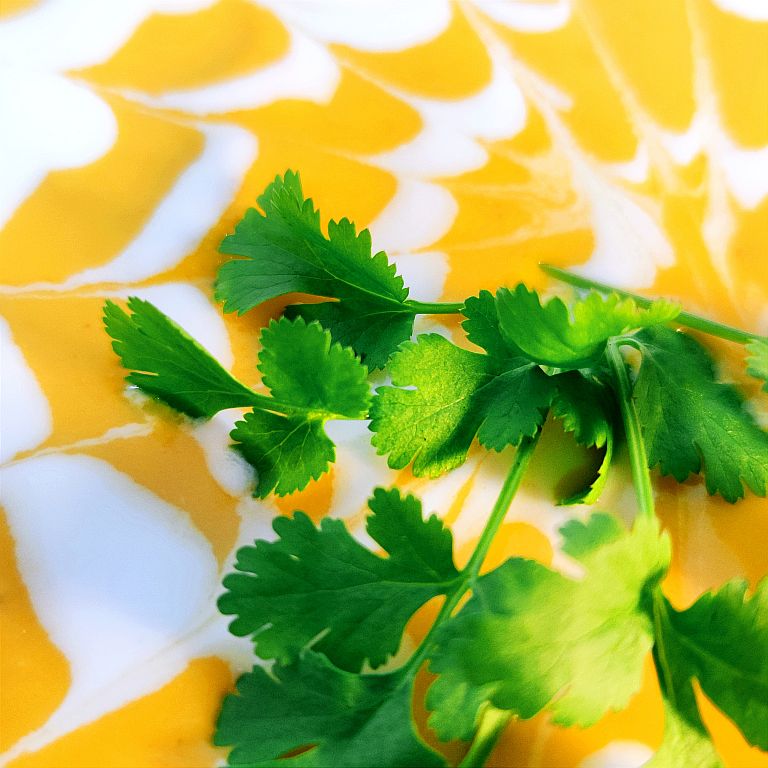
Curried carrot and swede soup
Description
This carrot and swede soup is perfectly creamy thanks to the coconut milk, just rightly aromatic and spicy thanks to the Panang curry paste and gets a fruity kick from the orange juice.
Ingredients
Instructions
-
Peel the swede by slicing off the outer skin all around with a sharp chef's knife. The best way to do this is to halve the swede and place it cut side down on the cutting board so that it has a secure footing and you don't slip off with the knife. Once you've peeled them, cut them into 1-2 cm cubes.
-
Peel the carrots and cut them into slices about 1 cm wide.
-
Peel and thinly slice the garlic clove.
-
Place the diced vegetables and garlic slices in a large saucepan and pour in enough vegetable broth to barely cover the diced vegetables.
-
Bring the vegetables to the boil on a high heat and then simmer on a low heat until the vegetables are soft (approx. 20 min). There should be little resistance when you poke a vegetable cube with a small kitchen knife or fork.
-
Remove the pot from the hot cooker and let it cool down a little so that the contents are easier to handle. Then puree the vegetables and vegetable stock as finely as possible - a high-powered stationary blender is best for this, but you can also use a hand blender.
-
In a second saucepan, bring the coconut milk to the boil and simmer until it reaches a thicker, creamy consistency. Now stir the Thai curry paste into the coconut milk.
-
Now add the pureed vegetables and the orange juice. Depending on the desired consistency, you can add more vegetable stock and coconut milk. The soup should be creamy and relatively thick. (At least I made it thicker, but feel free to finish it with a thinner consistency, it's up to you). Season the soup to your taste with salt, pepper, orange juice and Thai curry paste.
-
Serve the soup with a swirl of coconut milk and garnished with fresh coriander leaves.
